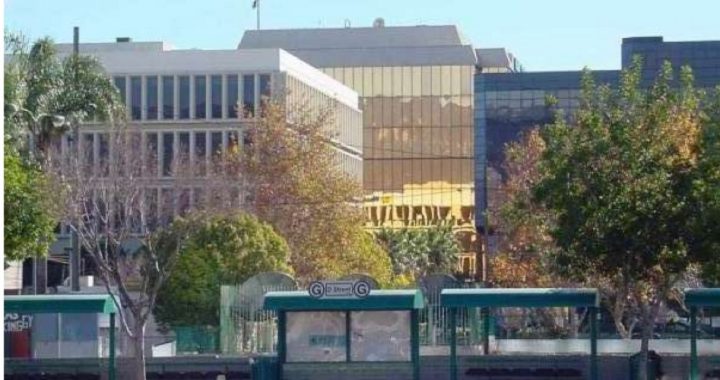
Part of the “pendency plan” that the San Bernardino, California, city council reluctantly passed on Monday includes provisions to “renegotiate” its agreement with CalPERS, the California Public Employees’s Retirement System. It’s not sitting well with the trustees of that system, the largest in the country, and they’re fighting it in court.
Years of excessive spending and impossible promises by the city council came to a head in August when the city almost ran out of money, and decided, at the last possible moment, to declare bankruptcy.
It isn’t that the council was caught by surprise or could claim ignorance. They were warned of the impending disaster two years ago, in August 2010, when San Bernardino’s then-city manager, Charles McNeely, gave the council his “Groundhog Day” presentation. McNeely saw what was coming as a result of the council’s continued refusal to face reality. Ignoring the impending impact of falling revenues and rising pension costs, the council sat on its hands. One of those city council members, Tobin Brinker, said McNeely used the Groundhog Day analogy “because the city had every year been doing the same stupid things.”
Even McNeely was late. He based his presentation on a study of the city’s finances done three years earlier by an outside management firm and ignored by the council. In his presentation he even predicted how much the shortfall would be, and when: the middle of 2012 and $40 million. When he left the meeting that day, McNeely said:
I don’t know how you could come out of that meeting not understanding [that] we had a serious problem. I told them, “You’re headed for trouble…. It’s a train wreck…. You can’t keep doing business this way.”
The council refused to recognize the seriousness — the reality — and instead just fiddled around with some minor adjustments such as some pay cuts, modest layoffs, deferring some purchases, tapping some reserves, borrowing funds held by a now-defunct development agency, and selling off some of the city’s assets. It was enough to solve the immediate problem, but didn’t address the underlying issue: pension obligations that far exceeded the city’s ability to pay for them.
This was complicated by the fact that the city unions had some supporters on the council who successfully diverted attention away from the problem. And so McNeely quit: “I didn’t see them dealing with the issues and I didn’t want to be a part of that anymore.”
The shortfall is nearly $46 million and the “pendency plan” just passed by the council hopes to close the gap mostly by stiffing CalPERS. The city has missed every biweekly payment of $1.2 million to the massive pension plan ever since it declared itself bankrupt in August, and now wants to “renegotiate” the $6 million it now owes by putting off making any payments until next year, and then setting up a payment plan to pay back the $6 million over the next 30 years.
But the problem is much more serious than the city’s present inability to make those $1.2 million payments every two weeks. It’s that the pension liability to the city for its overgenerous promises made in the past is so much larger: The city calculates that it is $143 million. CalPERS thinks the city owes them more than twice as much: $319 million.
The “pendency plan” threatens an underlying principle in municipal bankruptcy law: Pension obligations cannot be erased in bankruptcy. When Stockton and Vallejo declared bankruptcy, both cities continued to make their payments to CalPERS and left their other creditors to pick up the pieces.
Not this time.
CalPERS has already formally objected to the council’s “pendency plan” and has said that if it fails to keep the plan from being approved, it will take legal action to recoup the city’s unpaid contributions.
In its plea to the judge, the “pendency plan” says:
Without restructuring its finances or maintaining the protection of Chapter 9, the City could not pay its employees, retirees, bondholders or vendors. This would result in uncontrolled default and, presumably, a collapse of public services.
Moody’s, the credit rating service, is watching developments in San Bernardino closely:
If either San Bernardino or Compton [another California city owing CalPERS back payments] succeeds in redefining its pension obligations, it would set a precedent that CalPERS … can be [forcibly] brought to the negotiating table.
CalPERS, however, has every incentive to pursue all of its legal rights … to make these cities pay … and so discourage other fiscally-stressed California municipalities from withholding their required pension payments.
Privately, Eric Hoffmann, a vice-president at Moody’s, said that if CalPERS can be treated just like any other creditor in the San Bernardino bankruptcy, those other creditors would benefit. There would be larger pieces of the pie available to them during negotiations. Said Hoffman: “If CalPERS is deemed an unsecured creditor, other San Bernardino creditors and creditors of other municipalities in bankruptcy could be better off.”
What is clear is that San Bernardino, just like the United States, is bankrupt, with little prospect for real solutions to the problems wrought by profligate spending and promises to special interests. Retirees in San Bernardino are watching this situation very closely indeed, as one of the possible, indeed even likely, outcomes is to be a sharp reduction in their retirement checks.
Taxpayers aren’t likely to get off without pain, either. Revenues have dropped from $140 million a year to $120 million, while city spending even after the proposed “pendency plan” cuts will still remain far above revenues.
Bondholders are likely going to get haircuts, too, with little likelihood that their loans to the city will be paid off in full.
This is the mini “fiscal cliff” faced by San Bernardino, with painful similarities to the same, much larger, “fiscal cliff” faced by Congress in Washington. Whether fundamental change will occur in either location remains to be seen.
A graduate of Cornell University and a former investment advisor, Bob is a regular contributor to The New American and blogs frequently at www.LightFromTheRight.com, primarily on economics and politics. He can be reached at [email protected].



